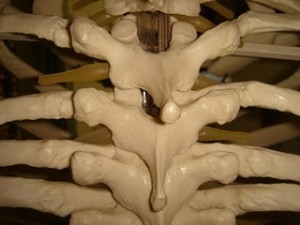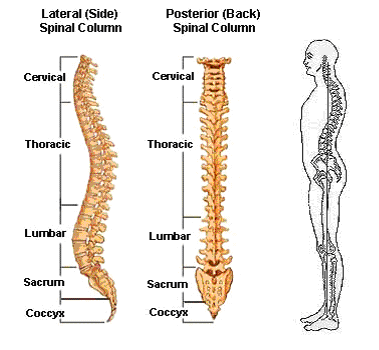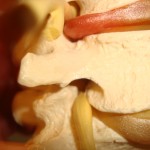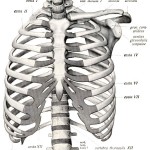- Allograft Bone
- Sterile bone derived from another human which is used for grafting procedures.
- Anterior
- The front portion of the body. It is often used to indicate the position of one structure relative to another.
- Annulus Fibrosus
- The outer, fibrous, ring–like portion of an intervertebral disc.
- Anterolateral
- Situated or occurring in front of and to the side.
- Apical Vertebra
- The most rotated vertebra in a curve; the most deviated vertebra from the patient’s vertical axis.
- Arthritis
- Inflammation of a joint usually characterized by swelling, pain, and restriction of motion.
- Arthrodesis
- The fusion of bones across a joint space, thereby limiting or eliminating movement. It may occur spontaneously or as a result of a surgical procedure, such as fusion of the spine.
- Arthropathy
- Any disease or disorder involving a joint.
- Arthroplasty
- The surgical remodeling of a diseased or damaged joint.
- Arthroscope
- An instrument inserted into a joint cavity to view the interior of a joint and correct certain abnormalities. An arthroscope is an endoscope for use in a joint.
- Arthroscopy
- The procedure of visualizing the inside of a joint by means of an arthroscope.
- Articular
- Pertaining to a joint.
- Autogenous Bone
- Bone originating from the same individual; i.e. an individual’s own bone.
- Autograft Bone
- Bone transplanted from one part to another part of the body in the same individual.
- Bone
- The hard tissue that provides structural support to the body. It is primarily composed of hydroxyapatite crystals and collagen. Individual bones may be classed as long, short, or flat.
- Bone Graft
- Bone which is harvested from one location in an individual and placed in another individual (allograft bone) or in a different location in the same individual (autogenous bone).
- Bone Marrow
- The tissue contained within the internal cavities of the bones. A major function of this tissue is to produce red blood cells.
- Bone Plate
- Usually a relatively thin metal device which is affixed to bone via screws. Bone plates are used to immobilize bones or bone fragments such that healing can occur.
- Bone Screw
- A threaded metal device which is inserted into bone. The functions of bone screws are to immobilize bones or bone fragments or to affix other medical devices, such as metal bone plates, to bones.
- Cancellous Bone
- The spongy or honeycomb structure of some bone tissue typically found at the ends of long bones.
- Cartilage
- The hard, thin layer of white glossy tissue that covers the end of bone at a joint. This tissue allows motion to take place with a minimum amount of friction.
- Centrum
- The body of a vertebra.
- Cervical
- The neck region of the spine containing the first seven vertebrae.
- Chemonucleolysis
- A treatment of an intervertebral disc that consists of an injection of chymopapain, a drug that dissolves part of the disc.
- Cobb Angle Measurement
- Calculated by selecting the upper and lower end vertebrae in a curve. Erecting perpendiculars to their transverse axes. At their point of intersection, the angle is measured to indicate the curve’s angle.
- Coccyx
- The region of the spine below the sacrum. It is also known as the tailbone.
- Collagen
- A fibrous protein which is a major constituent of connective tissue, such as skin, tendons, ligaments, cartilage, and bones.
- Comminuted Fracture
- A fracture in which a bone is broken into more than two pieces. Often internal or external fixation devices are used to maintain proper alignment of the fragments.
- Compensatory Curve
- A curve, which can be structural, above or below a major curve that tends to maintain normal body alignment.
- Compression
- The act of pressing together – refers to the loss of vertebral body height either anteriorly, posteriorly or both.
- Congenital
- Present at and existing from the time of birth.
- Coronal
- Refers to a section that divides the body into anterior and posterior portions.
- Cortical Bone
- Bone tissue which has been depleted of its minerals; e.g. calcium and phosphorous.
- Disc (Intervertebral)
- The tough, elastic structure that is between the bodies of spinal vertebrae. The disc consists of an outer annulus fibrosus enclosing an inner nucleus pulposus.
- Disc Degeneration
- The loss of the structural and functional integrity of the disc.
- Discectomy
- Surgical removal of part or all of an intervertebral disc.
- Distal
- Situated away from the center of the body.
- Distraction
- Excessive space between fracture fragments or vertebral segments due to interposed tissue or, most often, axial forces.
- End Vertebra
- i. The most cephalad (i.e. toward the head) vertebra of a curve, whose superior surface tilts maximally toward the concavity of the curve. ii. The most caudad (i.e. toward the coccyx) vertebra whose inferior surface tilts maximally toward the concavity of the curve.
- Endogenous
- Arising within or derived from the body.
- Endoscope
- A medical device for viewing internal portions of the body. It is usually comprised of fiber optic tubes and video display instruments.

- Endoscopy
- Inspection of internal body structures or cavities using an endoscope.
- Epidural
- Situated outside the thin, tough dural membrane that surrounds the brain and spinal cord.
- Excision
- Removal by cutting away material.
- Exogenous
- Originating outside of the body.
- Facet
- A posterior structure of a vertebra which articulates with a facet of an adjacent vertebra to form a facet joint that allows motion in the spinal column. Each vertebra has two superior and two inferior facets.
- Facetectomy
- Excision of a facet.
- Fatigue Fracture
- A fracture that occurs in bone or in other materials, including metal, as a result of repeated stress as opposed to a single injury.
- Fibrosis
- The replacement of normal tissue with scar tissue.
- Foramen
- A natural opening or passage in bone.
- Fracture
- A disruption of the normal continuity of bone.
- Fusion
- Union or healing of bone.
- Gibbus
- A sharply angular kyphos.
- Herniated Disc
- Extrusion of part of the nucleus pulposus material through a defect in the annulus fibrosus.
- Heterotopic Bone Formation
- The occurrence of bone growth in an abnormal location.
- Hook
- For spinal applications, a metallic medical device used to connect spinal structures to a rod.
- Hydroxyapatite (HA)
- The lattice–like structure of bone composed of calcium and phosphorous crystals which deposits on collagen to provide the rigid structure of bone.
- Iatrogenic
- Occurring without known cause. Self–originated.
- Iliac Bone
- A part of the pelvic bone that is above the hip joint and from which autogenous bone grafts are frequently obtained.
- Iliac Crest
- The large, prominent portion of the pelvic bone at the belt line of the body.
- Immobilization
- Limitation of motion or fixation of a body part usually to promote healing.
- Intervertebral Disc
- See Disc.
- In vitro
- Describing biological phenomena that are made to occur outside the living body (traditionally in a test tube). In vitro is Latin for in glass.
- In vivo
- Within a living body. In vivo is Latin for in life.
- Inferior
- Situated below or directed downward.
- Internal Fixation
- The immobilization of bone fragments or joints with implants in order to promote healing or fusion.
- Joint
- The junction or articulation of two or more bones that permits varying degrees of motion between the bones.
- Kyphosis
- An abnormal increase in the normal kyphotic curvature of the thoracic spine.
- Lamina
- An anatomical portion of a vertebra. For each vertebra, two lamina connect the pedicles to the spinous process as part of the neural arch.
- Laminectomy
- An operation for removal of part or all of the lamina of a vertebra, commonly performed in order to be able to remove an intervertebral disc protrusion or to decompress a nerve root.
- Laser
- Light Amplified by Stimulated Emission of Radiation. The device that produces a focused beam of light at a defined wavelength that can vaporize tissue. In surgery, lasers can be used to operate on small areas without damaging delicate surrounding tissue.
- Lateral
- Situated away from the midline of the body.
- Ligament
- A band of flexible, fibrous connective tissue that is attached at the end of a bone near a joint. The main function of a ligament is to attach bones to one another, to provide stability of a joint, and to prevent or limit some joint motion.
- Load Sharing
- Structural support through grafts and/or implants.
- Lordosis
- An abnormal increase in the normal lordotic curvature of the lumbar spine.
- Lumbago
- A non–medical term signifying pain in the lumbar region.
- Lumbar
- The lower part of the spine between the thoracic region and the sacrum. The lumbar spine consists of five vertebrae.
- Medial
- Situated closer to the midline of the body.
- Minimally Invasive Surgery
- Surgery requiring small incision(s), usually performed with endoscopic visualization.
- Neurosurgery
- The surgical speciality involved in the treatment of disorders of the brain, spinal cord, and peripheral nerves.
- Nerve Root
- The bony arch of the posterior aspect of a vertebra that surrounds the spinal cord, also referred to as the vertebral arch.
- Non–Union
- Failure of the fragments of a fractured bone to heal or to obtain bony fusion following an arthrodesis.
- Nucleus Pulposus
- The semi–gelatinous tissue in the center of an intervertebral disc. It is surrounded and contained by the annulus fibrosus which prevents this material from protruding outside the disc space.
- Orthopaedics (also Orthopedics)
- The medical specialty involved in the preservation and restoration of function of the musculoskeletal system that includes treatment of spinal disorders and peripheral nerve lesions.
- Ossification
- The process of forming bone in the body.
- Osteoporosis
- A disorder in which bone is abnormally brittle, less dense, and is the result of a number of different diseases and abnormalities.
- Pathology
- The study of disease states.
- Pedicle
- The part of each side of the neural arch of a vertebra. It connects the lamina with the vertebral body.
- Pelvic Obliquity
- Deviation of the pelvis from the horizontal in the frontal plane. Fixed pelvic obliquities can be attributed to contractures either above or below the pelvis.
- Periosteum
- A fibrous membrane that covers the surface of bone except at the end of the bones where it is covered with cartilage as part of a joint. In children, periosteum is involved in forming new bone and molding the configuration of bone; and in the adult, the periosteum forms new bone secondary to injury or infection.
- Physical Therapy
- The treatment consisting of exercising specific parts of the body such as the legs, arms, hands or neck, in an effort to strengthen, regain range of motion, relearn movement and/or rehabilitate the musculoskeletal system to improve function.
- Physiology
- The science of the functioning of living organisms, and of their component systems or parts.
- Posterior
- Located behind a structure, such as relating to the back side of the human body.
- Prosthesis
- An artificial body part such as an artificial leg or arm. The term prosthesis is also used to describe some of the implants used in the body such as a hip or knee replacement device.
- Proximal
- Nearest the center of the body.
- Pseudoarthrosis (also Pseudarthrosis)
- A form of a non–union in which there is the formation of a false joint with some cartilage covering the ends of the bones and a cavity containing fluid that resembles a normal joint.
- Resection
- The surgical removal of part of a structure, such as bone.
- Resorption
- The removal of bone tissue by normal physiological process or as part of a pathological process such as an infection.
- Rhizotomy
- Surgical transection of a nerve root.
- Rib Hump
- The prominence of the ribs on the convexity of a spinal curvature, usually due to vertebral rotation best exhibited on forward bending.
- Rod
- In spinal applications, a slender, metal implant which is used to immobilize and align the spine.
- Rotation
- The movement of one vertebra to another about its normal or abnormal coronal axis.
- Ruptured Disc
- See Herniated Disc.
- Sacrum
- A part of the spine that is also part of the pelvis. It articulates with the ilia at the sacroiliac joints and articulates with the lumbar spine at the lumbosacral joint. The sacrum consists of five fused vertebrae that have no intervertebral discs.
- Sagittal
- Refers to a lengthwise cut that divides the body into right and left portions.
- Sciatica
- A lay term indicating pain along the course of a sciatic nerve, especially noted in the back of the thigh and below the knee.
- Scoliosis
- Lateral (sideways) curvature of the spine.
- Sepsis
- A state of infection of tissue due to disease–producing bacteria or toxins.
- Skeleton
- The rigid framework of bones that gives form to the body, protects and supports the soft organs and tissues, and provides attachments for muscles.
- Spinal Stenosis
- Reduction in the diameter of the spinal canal due to new bone formation which may result in pressure on the spinal cord or nerve roots.
- Spinal Disc
- See Disc (Intervertebral).
- Spinal Column
- See Spine.
- Spinal Fusion
- A surgical procedure to permanently join bone by interconnecting two or more vertebrae in order to prevent motion (see Arthrodesis).
- Spinal Canal
- The bony channel that is formed by the intravertebral foramen of the vertebrae and in which contains the spinal cord and nerve roots.
- Spinal Cord
- The longitudinal cord of nerve tissue that is enclosed in the spinal canal. It serves not only as a pathway for nervous impulses to and from the brain, but as a center for carrying out and coordinating many reflex actions independently of the brain.
- Spine
- The flexible bone column extending from the base of the skull to the tailbone. It is made up of 33 bones, known as vertebrae. The first 24 vertebrae are separated by discs known as intervertebral discs, and bound together by ligaments and muscles. Five vertebrae are fused together to form the sacrum and 4 vertebrae are fused together to form the coccyx. The spine is also referred to as the vertebral column, spinal column, or backbone.
- Spondylitis
- Inflammation of vertebrae.
- Spondylolisthesis
- A defect in the construct of bone between the superior and inferior facets with varying degrees of displacement so the vertebra with the defect and the spine above that vertebra are displaced forward in relationship to the vertebrae below. It is usually due to a developmental defect or the result of a fracture.
- Spondylolysis
- Displacement of one vertebra over another with fracture of a posterior portion of the vertebra. A defect in the neural arch between the superior and inferior facets of vertebrae without separation at the defect and therefore no displacement of the vertebrae. It may be unilateral or bilateral and is usually due to a developmental defect but may be secondary to a fracture.
- Stainless Steel
- Iron–based metal containing chromium that is highly resistant to stain, rust, and corrosion. Certain grades of stainless steel are commonly used to make surgical implants and instruments.
- Sterile
- Free from living organisms.
- Sterilization
- The method used to render a material free from living organisms. Usual methods include steam under pressure, gas, and ionizing radiation.
- Superior
- Situated above or directed upward toward the head of an individual.
- Tendon
- The fibrous band of tissue that connects muscle to bone. It is mainly composed of collagen.
- Thoracic
- The chest level region of the spine that is located between the cervical and lumbar vertebrae. It consists of 12 vertebrae which serve as attachment points for ribs.
- Titanium
- A metallic element used to make surgical implants.
- Toxicology
- The study of the toxic or harmful effects of substances on the body.
- Translation
- Vertebral body displacement – can describe lateral, anterior or posterior displacement.
- Transplant
- The implantation of bone tissue, as in grafting, from one part of the body to another, or from one individual to another. Transplant also refers to the transfer of an organ such as a kidney or heart from one individual to another.
- Transverse
- Refers to a cut that divides the body into superior and inferior portions.
- Vertebra
- One of the 33 bones of the spinal column. A cervical, thoracic, or lumbar vertebra has a cylindrically–shaped body anteriorly and a neural arch posteriorly (composed primarily of the laminae and pedicles as well as the other structures in the posterior aspect of the vertebra) that protects the spinal cord. The plural of vertebra is vertebrae.
- Vertebral End–Plates
- The superior and inferior plates of cortical bone of the vertebral body adjacent to the intervertebral disc.
- Wire
- Metal thread available in various diameters and various degrees of stiffness and is generally used in surgery to transfix fractured bone.


